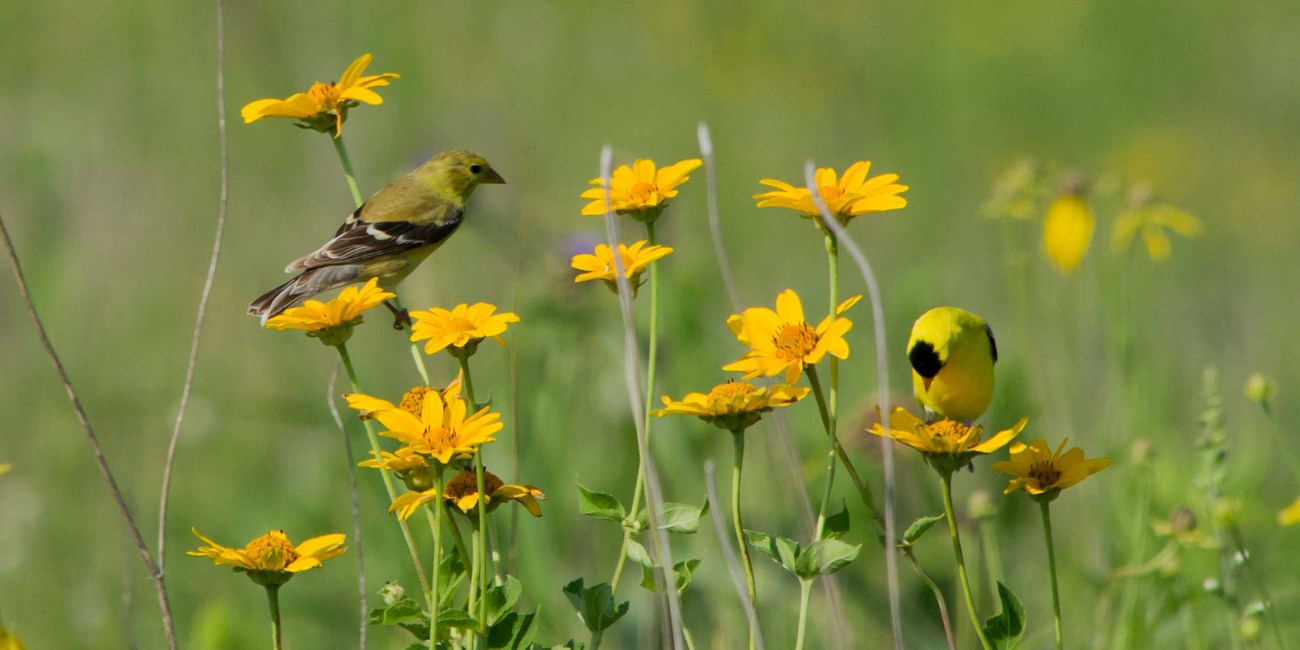Last updated: February 12, 2021
Article
Tall Grasses to Tall Corn & Back Again

Erin Anfinson
"I was taken for a summer to live with Uncle Pennington Minthorn in Sioux County, Iowa, where he was breaking in a prairie farm. We lived in a sod house and I was privileged to ride the lead horse of a team which was opening the virgin soil."
Herbert Hoover
The tallgrass prairie at Herbert Hoover National Historic Site offers a glimpse of an Iowa landscape that had almost vanished by the time Hoover's grandparents moved to West Branch in 1854. The National Park Service reconstructed the tallgrass prairie in 1971 to represent the vast grassland that once covered 85 percent of Iowa. The park planted native species of grasses on land that had been farm fields for more than a century.
Valuable Farmland
Tall native grasses, sprinkled with brilliantly colored wildflowers once covered Iowa's rolling hills for as far as the eye could see. Trees were scarce until planted; the Hoovers imported lumber from farther north for construction of the president’s birthplace.
Iowa's prairies became some of the most valuable farmland in the world. The plowed fields of the Isaac Miles Farm characterized the immediate landscape during Hoover’s youth. Prairie remnants persisted along the creeks and railroad tracks where Hoover spent many boyhood hours exploring.
Today less than one percent of prairie land still exists in Hoover's home state. This is one reason the National Park Service returned this historic cultivated field to much of its original splendor. Because their root systems run as deep as the plants are tall, native prairie grasses are well-adapted for controlling runoff and stabilizing areas susceptible to erosion.
Grasses & Wildflowers
Botanists call prairie grasses "warm-season" grasses, because they grow abundantly in hot weather. These grasses form their seed heads in late summer and fall.
The most abundant prairie grass is big bluestem with some Indian grass, switchgrass, little bluestem, side-oats grama, and Canada wild rye. Visitors may find small patches of Virginia wild rye and slough or cord grass in wet parts of the prairie. The prairie includes about five acres of wet meadow. The remaining area is drier upland habitat.
A colorful array of flowers mixes with the green, purple, and golden hues of native grasses from April until late October. Golden alexanders, Canada anemones, spiderworts, yellow and purple coneflowers, and butterfly milkweeds in spring and early summer. New England asters and numerous species of goldenrods attract monarch butterflies when they peak in late summer and early fall.
Numerous other species have appeared by natural reintroduction from outside the park. Nonnative species, including some attractive wildflowers, have escaped into the park as well.
Nonnative Plants
Nonnative plants and woody vegetation continue to degrade sections of the tallgrass prairie. Land uses surrounding the prairie and the proximity of ornamental plantings contribute to invasions of exotic species. Reed canary grass and shrubs have become abundant along the creek banks and rills of the prairie.
In areas that are diverse and well-populated with native grasses and forbs, natural competition appears to be sustaining native plants. Treatment with prescribed fire, physical removal, and herbicides, followed by native seed collection and redistribution can help to control invasive and exotic species.
Birds
Herbert Hoover National Historic Site is on the Mississippi flyway, a major bird migration route. Many species rest and take refuge in the park's reconstructed tallgrass prairie and along its quiet stream. Their colors and songs add visible and audible vitality to the park's dignified commemorative setting.
Park staff and volunteers monitor long-term changes in breeding bird populations to evaluate the quality of habitat the park provides. The presence or absence of grassland birds like sedge wrens, dickcissels, grasshopper sparrows, Henslow's sparrows, bobolinks, and eastern meadowlarks indicate the prairie's overall health. Populations of these species decline as prairies disappear from the landscape. Several species are of continental importance because of their dwindling numbers.
Prairie Management
The National Park Service uses many techniques to continue the reconstruction of the prairie. "Over-seeding" adds native plant seeds into the existing vegetation, while mowing, hand-removal, herbicides, and prescribed fire remove nonnative species or give the native ones a chance to thrive. Volunteers often help park staff with the manual removal of woody plants and invasive weeds from the grassland. The park's management plans outline strategies for managing the restored tallgrass prairie. Scientific research helps park managers evaluate the reconstruction and maintenance techniques by measuring the overall health of the prairie.
Historically, tallgrass prairies experienced repeated natural fires every five to ten years. These fires were frequent and of low severity, eliminating most of the young woody species that had established since the previous fire and rejuvenating perennial grasses and forbs. The park plans its fire management to reconstruct the prairie in the most effective and efficient manner, which includes the scientific use of prescribed fire.
